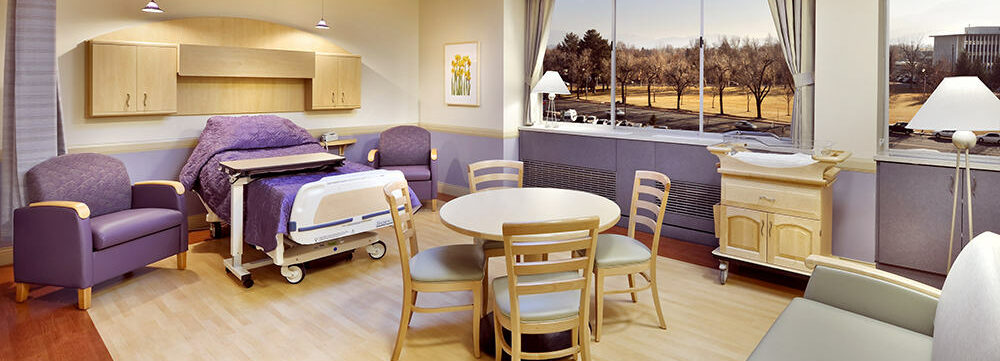Blog
Maternity Ward Design: Creating a Welcoming Haven for Mother, Baby, and Family

As a healthcare designer, I have had opportunities to create spaces that enhance the patient experience. One area that holds a special place in my heart is the design of maternity wards. These unique spaces play a vital role in ensuring the health and well-being of both the mother and baby. Today, I want to emphasize the importance of thoughtful Maternity Ward Design, which aims to create a warm, comforting environment for the mother, baby, and family. The featured image here is from a project that I helped complete back in 2008 while employed at HMC Architects. Even though the design is now over 15 years old, it’s still one of my favorites and the principles still apply. See more project photos.
Promoting Mother-Baby Bonding
The immediate postpartum period is crucial for bonding between the mother and her newborn. By designing private rooms that allow rooming-in, we create an environment that supports uninterrupted skin-to-skin contact, breastfeeding, and maternal-infant bonding. Personalized amenities and home-like comforts can also enhance this bonding experience, creating a safe and nurturing environment.
Facilitating Family-Centered Care
A vital aspect of Maternity Ward Design is ensuring spaces that cater to the entire family. Recognizing the significance of shared experiences and creating spaces where family members and siblings can bond with the new arrival is paramount. At Renown, we created an inviting atmosphere that encourages family involvement and support by incorporating flexible seating areas, family lounges, and overnight accommodations.
Ensuring Safety and Efficiency
While aesthetics and comfort are important, safety should always remain a top priority in Maternity Ward Design. The layout of the ward should prioritize ease of movement and reduce the risk of infection by utilizing separate flows for staff, patients, and visitors. The inclusion of state-of-the-art equipment, medical technology, and well-placed hand hygiene stations can contribute to a safe and efficient care environment.
Incorporating Nature and Natural Night
A healing and soothing environment can positively impact the emotional well-being of new mothers and their families. The inclusion of natural light, scenic views, and a connection to nature can create a serene atmosphere. Strategically placed windows, green spaces, and gardens can offer a respite from clinical surroundings, reducing the stress and anxiety associated with medical settings.
Tailoring Spaces for Diverse Needs
A mother’s physical and mental well-being greatly vary, making it essential to design spaces that cater to diverse needs. By creating areas for relaxation, privacy, and reflection, we offer mothers a sanctuary to decompress and recharge. Equally important is establishing spaces for education, support groups, and counseling sessions to ensure comprehensive care for the mother and her family long after discharge.
Maternity Ward Design: Creating a Welcoming Haven for Mother, Baby, and Family
Maternity Ward Design should be centered around the needs and experiences of mothers, babies, and their families. By considering elements such as bonding, family-centered care, safety, natural environments, and inclusiveness, designers can help create environments that promote healing, well-being, and positive outcomes. The role of design in healthcare settings goes beyond aesthetics; it has the power to shape experiences and contribute to healthier, happier families during this amazing and transformative journey. Let’s continue to prioritize thoughtful design in maternity wards, making them a beacon of hope, comfort, and joy for all who pass through their doors.
To see more about the renovation project of the postpartum/NICU until for Renown Health, visit WDS Projects.
Marie Wikoff is the creator of Wikoff Design Studio based out of Reno, Nevada. Her expertise in healthcare design has helped modernize healthcare organizations locally, regionally, and internationally, improving patient experience and outcomes. Her credentials include Evidence-Based Design Accreditation and Certification (EDAC), American Academy of Healthcare Interior Designer (CHID), the National Council of Interior Design Qualification (NCIDQ) and LEED AP. Contact Marie Wikoff







